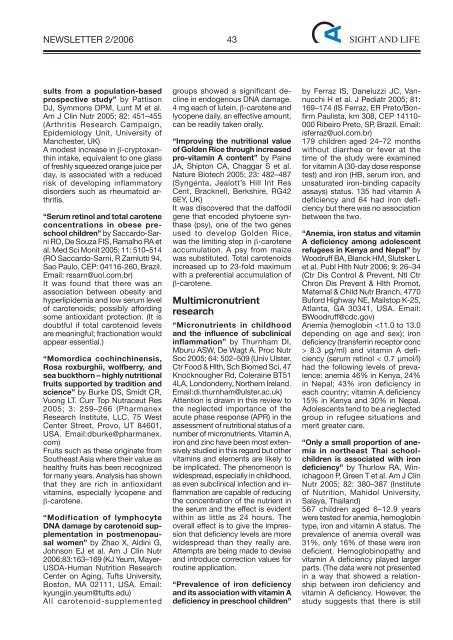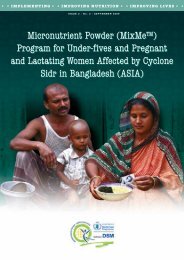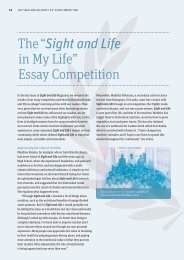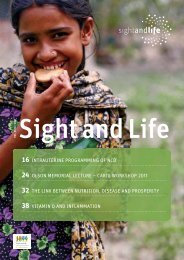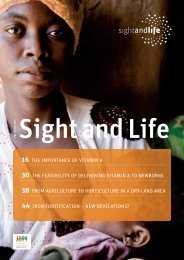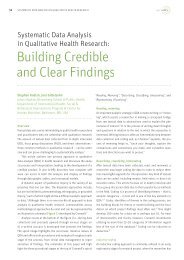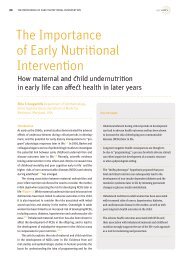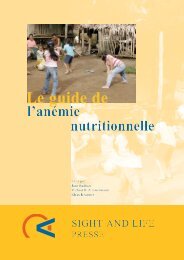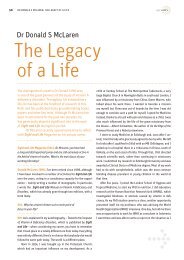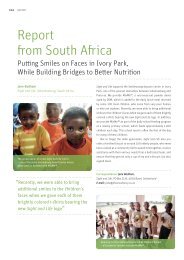Newsletter 02 2006.pdf - Sight and Life
Newsletter 02 2006.pdf - Sight and Life
Newsletter 02 2006.pdf - Sight and Life
Create successful ePaper yourself
Turn your PDF publications into a flip-book with our unique Google optimized e-Paper software.
NEWSLETTER 2/2006<br />
43<br />
SIGHT AND LIFE<br />
sults from a population-based<br />
prospective study” by Pattison<br />
DJ, Symmons DPM, Lunt M et al.<br />
Am J Clin Nutr 2005; 82: 451–455<br />
(Arthritis Research Campaign,<br />
Epidemiology Unit, University of<br />
Manchester, UK)<br />
A modest increase in β-cryptoxanthin<br />
intake, equivalent to one glass<br />
of freshly squeezed orange juice per<br />
day, is associated with a reduced<br />
risk of developing inflammatory<br />
disorders such as rheumatoid arthritis.<br />
“Serum retinol <strong>and</strong> total carotene<br />
concentrations in obese preschool<br />
children” by Saccardo-Sarni<br />
RO, De Souza FIS, Ramalho RA et<br />
al. Med Sci Monit 2005; 11: 510–514<br />
(RO Saccardo-Sarni, R Zamlutti 94,<br />
Sao Paulo, CEP: 04116-260, Brazil.<br />
Email: rssarn@uol.com.br)<br />
It was found that there was an<br />
association between obesity <strong>and</strong><br />
hyperlipidemia <strong>and</strong> low serum level<br />
of carotenoids; possibly affording<br />
some antioxidant protection. (It is<br />
doubtful if total carotenoid levels<br />
are meaningful; fractionation would<br />
appear essential.)<br />
“Momordica cochinchinensis,<br />
Rosa roxburghii, wolfberry, <strong>and</strong><br />
sea buckthorn – highly nutritional<br />
fruits supported by tradition <strong>and</strong><br />
science” by Burke DS, Smidt CR,<br />
Vuong LT. Curr Top Nutraceut Res<br />
2005; 3: 259–266 (Pharmanex<br />
Research Institute, LLC, 75 West<br />
Center Street, Provo, UT 84601,<br />
USA. Email:dburke@pharmanex.<br />
com)<br />
Fruits such as these originate from<br />
Southeast Asia where their value as<br />
healthy fruits has been recognized<br />
for many years. Analysis has shown<br />
that they are rich in antioxidant<br />
vitamins, especially lycopene <strong>and</strong><br />
β-carotene.<br />
“Modification of lymphocyte<br />
DNA damage by carotenoid supplementation<br />
in postmenopausal<br />
women” by Zhao X, Aldini G,<br />
Johnson EJ et al. Am J Clin Nutr<br />
2006;83:163–169 (KJ Yeum, Mayer-<br />
USDA-Human Nutrition Research<br />
Center on Aging, Tufts University,<br />
Boston, MA <strong>02</strong>111, USA. Email:<br />
kyungjin.yeum@tufts.edu)<br />
All carotenoid-supplemented<br />
groups showed a significant decline<br />
in endogenous DNA damage.<br />
4 mg each of lutein, β-carotene <strong>and</strong><br />
lycopene daily, an effective amount,<br />
can be readily taken orally.<br />
“Improving the nutritional value<br />
of Golden Rice through increased<br />
pro-vitamin A content” by Paine<br />
JA, Shipton CA, Chaggar S et al.<br />
Nature Biotech 2005; 23: 482–487<br />
(Syngenta, Jealott’s Hill Int Res<br />
Cent, Bracknell, Berkshire, RG42<br />
6EY, UK)<br />
It was discovered that the daffodil<br />
gene that encoded phytoene synthase<br />
(psy), one of the two genes<br />
used to develop Golden Rice,<br />
was the limiting step in β-carotene<br />
accumulation. A psy from maize<br />
was substituted. Total carotenoids<br />
increased up to 23-fold maximum<br />
with a preferential accumulation of<br />
β-carotene.<br />
Multimicronutrient<br />
research<br />
“Micronutrients in childhood<br />
<strong>and</strong> the influence of subclinical<br />
inflammation” by Thurnham DI,<br />
Mburu ASW, De Wagt A. Proc Nutr<br />
Soc 2005; 64: 5<strong>02</strong>–509 (Univ Ulster,<br />
Ctr Food & Hlth, Sch Biomed Sci, 47<br />
Knocknougher Rd, Coleraine BT51<br />
4LA, Londonderry, Northern Irel<strong>and</strong>.<br />
Email:di.thurnham@ulster.ac.uk)<br />
Attention is drawn in this review to<br />
the neglected importance of the<br />
acute phase response (APR) in the<br />
assessment of nutritional status of a<br />
number of micronutrients. Vitamin A,<br />
iron <strong>and</strong> zinc have been most extensively<br />
studied in this regard but other<br />
vitamins <strong>and</strong> elements are likely to<br />
be implicated. The phenomenon is<br />
widespread, especially in childhood,<br />
as even subclinical infection <strong>and</strong> inflammation<br />
are capable of reducing<br />
the concentration of the nutrient in<br />
the serum <strong>and</strong> the effect is evident<br />
within as little as 24 hours. The<br />
overall effect is to give the impression<br />
that deficiency levels are more<br />
widespread than they really are.<br />
Attempts are being made to devise<br />
<strong>and</strong> introduce correction values for<br />
routine application.<br />
“Prevalence of iron deficiency<br />
<strong>and</strong> its association with vitamin A<br />
deficiency in preschool children”<br />
by Ferraz IS, Daneluzzi JC, Vannucchi<br />
H et al. J Pediatr 2005; 81:<br />
169–174 (IS Ferraz, ER Preto/Bonfirm<br />
Paulista, km 308, CEP 14110-<br />
000 Ribeiro Preto, SP, Brazil. Email:<br />
isferraz@uol.com.br)<br />
179 children aged 24–72 months<br />
without diarrhea or fever at the<br />
time of the study were examined<br />
for vitamin A (30-day dose response<br />
test) <strong>and</strong> iron (HB, serum iron, <strong>and</strong><br />
unsaturated iron-binding capacity<br />
assays) status. 135 had vitamin A<br />
deficiency <strong>and</strong> 64 had iron deficiency<br />
but there was no association<br />
between the two.<br />
“Anemia, iron status <strong>and</strong> vitamin<br />
A deficiency among adolescent<br />
refugees in Kenya <strong>and</strong> Nepal” by<br />
Woodruff BA, Blanck HM, Slutsker L<br />
et al. Publ Hlth Nutr 2006; 9: 26–34<br />
(Ctr Dis Control & Prevent, Ntl Ctr<br />
Chron Dis Prevent & Hlth Promot,<br />
Maternal & Child Nutr Branch, 4770<br />
Buford Highway NE, Mailstop K-25,<br />
Atlanta, GA 30341, USA. Email:<br />
BWoodruff@cdc.gov)<br />
Anemia (hemoglobin 8.3 µg/ml) <strong>and</strong> vitamin A deficiency<br />
(serum retinol < 0.7 µmol/l)<br />
had the following levels of prevalence:<br />
anemia 46% in Kenya, 24%<br />
in Nepal; 43% iron deficiency in<br />
each country; vitamin A deficiency<br />
15% in Kenya <strong>and</strong> 30% in Nepal.<br />
Adolescents tend to be a neglected<br />
group in refugee situations <strong>and</strong><br />
merit greater care.<br />
“Only a small proportion of anemia<br />
in northeast Thai schoolchildren<br />
is associated with iron<br />
deficiency” by Thurlow RA, Winichagoon<br />
P, Green T et al. Am J Clin<br />
Nutr 2005; 82: 380–387 (Institute<br />
of Nutrition, Mahidol University,<br />
Salaya, Thail<strong>and</strong>)<br />
567 children aged 6–12.9 years<br />
were tested for anemia, hemoglobin<br />
type, iron <strong>and</strong> vitamin A status. The<br />
prevalence of anemia overall was<br />
31%, only 16% of these were iron<br />
deficient. Hemoglobinopathy <strong>and</strong><br />
vitamin A deficiency played larger<br />
parts. (The data were not presented<br />
in a way that showed a relationship<br />
between iron deficiency <strong>and</strong><br />
vitamin A deficiency. However, the<br />
study suggests that there is still


